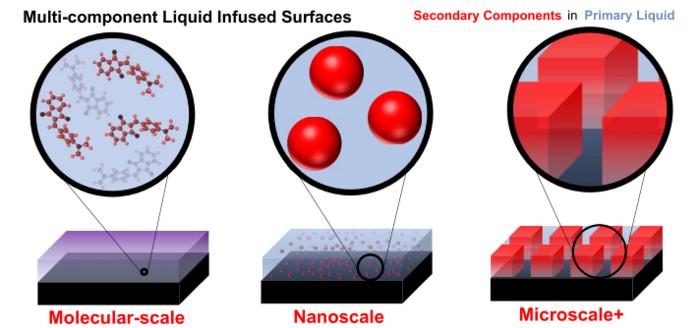Surface coatings have long been essential in various industries, offering protection and functionality. In recent years, liquid-infused surfaces (LIS) have emerged as a groundbreaking technology, revolutionizing how we approach surface coatings. In a review article recently published in Industrial Chemistry & Materials on Feb. 23, 2024, authors Zachary Applebee and Dr. Caitlin Howell explore a novel approach in surface technology that could significantly impact various industries, including healthcare and environmental conservation. A new frontier is emerging: multi-component liquid-infused systems, or LIS containing more than one component in the liquid. The research introduces the concept of multi-component liquid-infused surfaces as a sophisticated advancement beyond the single-component liquid coatings that have dominated the field since their inception in the early 2010s.
These innovative multi-component surface coatings don’t just have one purpose; they are designed to be dynamic, capable of actively responding to their environment by incorporating multiple elements into the liquid layer. This versatility allows for a myriad of applications, from medical devices that both passively and actively combat infection to advanced carbon-capture systems and chemical delivery mechanisms controlled by magnetic fields.

Credit: Caitlin Howell, University of Maine, USA
Surface coatings have long been essential in various industries, offering protection and functionality. In recent years, liquid-infused surfaces (LIS) have emerged as a groundbreaking technology, revolutionizing how we approach surface coatings. In a review article recently published in Industrial Chemistry & Materials on Feb. 23, 2024, authors Zachary Applebee and Dr. Caitlin Howell explore a novel approach in surface technology that could significantly impact various industries, including healthcare and environmental conservation. A new frontier is emerging: multi-component liquid-infused systems, or LIS containing more than one component in the liquid. The research introduces the concept of multi-component liquid-infused surfaces as a sophisticated advancement beyond the single-component liquid coatings that have dominated the field since their inception in the early 2010s.
These innovative multi-component surface coatings don’t just have one purpose; they are designed to be dynamic, capable of actively responding to their environment by incorporating multiple elements into the liquid layer. This versatility allows for a myriad of applications, from medical devices that both passively and actively combat infection to advanced carbon-capture systems and chemical delivery mechanisms controlled by magnetic fields.
“In this review, we explore the untapped potential of multi-component liquid-infused surfaces,” explains Zach Applebee, a graduate researcher at the University of Maine. “By integrating various elements into the liquid coating, we can achieve synergistic effects that enhance functionality in ways previously thought impossible. This opens up new avenues for innovation in both industry and medicine.”
The study categorizes these surfaces based on the size of their secondary components, ranging from molecular to microscale, and presents examples demonstrating how the inclusion of additional elements can lead to groundbreaking advancements. The review not only highlights the diversity of fabrication methods but also sets the stage for future research directions in this promising field. “The most important message in our review is that the liquid nature of liquid-infused coatings is a game-changer in creating surfaces that adapt and respond,” explains Caitlin Howell, a professor at the University of Maine. “By leveraging the natural processes of liquids, such as diffusion, flow, and return to equilibrium, we can begin to design systems that dynamically move or place secondary materials, whether molecules, nanoparticles, or even other immiscible liquids, exactly where we want, when we want. The possibilities are endless.”
The researchers are optimistic about the future of this technology. They believe that as more scientists and engineers become aware of the possibilities offered by multi-component liquid-infused surfaces, a wave of innovation will follow, leading to the development of materials and systems that could significantly improve our quality of life and address some of the world’s most pressing challenges.
“We believe that multi-component liquid-infused surfaces are well positioned to begin to address a wide range of problems once more researchers become aware of them,” says Dr. Howell, “and could be instrumental in designing new highly targeted drug-delivery systems or creating industrial surfaces that can adapt to different types of foulants in real-time.”
Industrial Chemistry & Materials is a peer-reviewed interdisciplinary academic journal published by Royal Society of Chemistry (RSC) with APCs currently waived. Icm publishes significant innovative research and major technological breakthroughs in all aspects of industrial chemistry and materials, especially the important innovation of the low-carbon chemical industry, energy, and functional materials.
Journal
Industrial Chemistry and Materials
DOI
10.1039/D4IM00003J
Method of Research
Literature review
Subject of Research
Not applicable
Article Title
Multi-component liquid-infused systems: a new approach to functional coatings
Article Publication Date
23-Feb-2024




